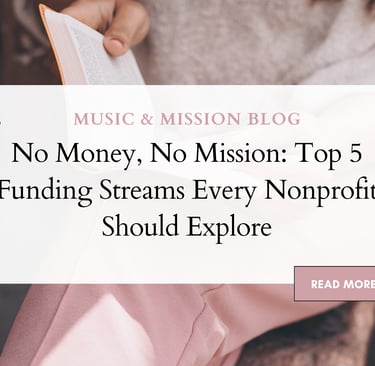No Money, No Mission: Top 5 Funding Streams Every Nonprofit Should Explore
Striking the right chord between art and impact—nonprofits that diversify their revenue streams are more likely to succeed. From individual donors and foundation grants to corporate matching gifts, music-based events, fiscal sponsorship, and earned-income programming, here are the five funding streams your nonprofit can amplify for lasting resonance.
Marlen R. Wolfe
8/11/20254 min read


No Money, No Mission: Top 5 Funding Streams Every Nonprofit Should Explore
The saying goes “no money, no mission,” and it sounds harsh, but it is true. Passion and purpose can’t sustain a nonprofit alone. Just like a for-profit business depends on multiple income streams to survive market shifts, a nonprofit must prioritize building a healthy, diversified funding base. Too many organizations lean on a single source—often grants—only to face crisis when that stream slows or stops.
A resilient nonprofit treats funding streams like a portfolio, balancing short-term income with long-term sustainability. The goal isn’t just survival—it’s growth, innovation, and the ability to meet your mission regardless of the funding landscape.
If you are new to the nonprofit field, and don't even know where to start, below are five key funding streams every nonprofit should explore, why they matter, and practical ways to start finding opportunities in your own network.
1. Individual Donors (Minor & Major)
Why it matters:
Individuals are consistently the largest source of charitable giving in the U.S. A strong base of small donors can provide reliable, recurring income, while major donors can dramatically expand your capacity or fund big initiatives. Both are crucial for stability and growth.
How to start researching your network to identify donors:
Look at your inner circle: Board members, volunteers, event attendees, and past donors.
Organize them by giving potential: A “minor donor” might give $25–$250 annually; “major” can mean anything from $500 to $50,000+ depending on your nonprofit’s scale.
Look for connection points: Who in your network shares your passion or has benefited from your work?
Don't know them but know they give to nonprofits like yours? Ask for introductions: Leverage your board and close supporters to connect you to people with both interest and capacity.
Pro Tip: Before asking for money, invest in building genuine relationships. Invite people to awareness events, share updates, and get them emotionally connected to your cause. It takes several touchpoints with a donor before an ask should be made, and you will figure out how many touchpoints for yourself.
2. Foundation & Government Grants
Why it matters:
Private foundations, corporate foundations, and government agencies award billions annually to nonprofits that align with their priorities. A single grant can launch a program or help you scale quickly, but depending on the size of the foundation or the fund, competition is high and applications are often complex. There are smaller grants for which the process is simpler to apply for, so if you are new to the grant world, I suggest starting small, showing your ability to properly administer the funds, and then scale up in size and amount requested.
How to start researching your network:
Identify mission alignment: Search for funders who have supported work similar to yours.
Tap into your network: Ask peers, board members, and community partners about funders they’ve worked with in the past.
Use grant databases: Foundation Directory Online, GrantWatch, Neddie, and local community foundation listings are excellent starting points. If you are a larger nonprofit ready to invest in serious software for your team, I highly recommend Instrumentl.
Track deadlines & cycles: Many grants are annual—missing a window can mean waiting an entire year.
Pro Tip: Build relationships with program officers before applying. A 15-minute call to ask questions can help you stand out from the stack of applications.
3. Corporate Support (Sponsorships, Matching Gifts, & Volunteer Grants)
Why it matters:
Companies are eager to connect with causes that align with their values—and their customers’. Corporate support can include direct sponsorships, in-kind donations, matching employee gifts, and even cash grants tied to employee volunteer hours.
How to start researching your network:
Look at employers in your donor base or board: Many companies match employee gifts or offer volunteer grants—your donors may not even know it. Google, for example, gives each employee up to $2,000 to gift to the nonprofit of their choice.
Research local businesses: Identify companies that have a history of supporting community initiatives.
Track sponsorship seasons: Some corporations plan budgets a year ahead—timing matters, so don't expect to be funded in the same year you make a request or send out an appeal.
Pro Tip: Create pitches for partnerships that benefit both sides—visibility for the company and mission impact for you.
4. Fundraising Events & Crowdfunding
Why it matters:
Events or online campaigns are about more than money—they build community, energize supporters, and create moments that deepen donor loyalty. From intimate house concerts to large-scale galas, events can serve as both an entry point for new donors and a retention tool for loyal ones.
How to start researching your network:
Scan your calendar: Tie events to meaningful dates (anniversaries, awareness months, cultural celebrations).
Identify storytellers: Who in your network has a compelling personal connection to your mission? Feature them in campaigns!
Map your influencers: Friends, alumni, or program participants who can bring in their own networks.
Choose your platform: For crowdfunding, look at GoFundMe, GiveLively, or CauseVox.
Pro Tip: Always pair events and crowdfunding with a follow-up plan to steward attendees and donors into ongoing supporters.
5. Earned Income
Why it matters:
It is a common misconception that nonprofits can’t charge for their services—or that they all operate on a “free for everyone” model. In reality, many nonprofits generate revenue through memberships, ticketed events, sliding-scale or “pay what you can” fees, and other mission-aligned services. Earned income—charging for products or services tied directly to your mission—creates self-sufficiency and reduces reliance on unpredictable donations or grants.
How to start exploring earned income:
For earned income: Think about what you already do that people would pay for—workshops, performances, consulting, training. Even if you do a pay-what-you-can model, earned income allows you to plan for program scale based on revenue generated from this stream.
Survey your audience: Survey your community about what they’d value enough to purchase or pay for.
Pro Tip: Make sure your earned income activities align with your mission—mission drift can weaken your donor base and perceived integrity in your operations.
Final Thoughts
Your nonprofit’s funding health depends on diversity—relying on a single source is like playing an instrument with one string. Start by evaluating which of these streams you already use and which you can build over the next year. And remember, no matter the stream: fundraising is relationship-building. Every email, event, and conversation is an opportunity to connect people to the heart of your mission.
____________________
About Marlén, Let’s Build Together: If you're considering launching a nonprofit for your music or creative program, I’d love to connect. Whether you're just dreaming or already building, know that your work is needed — and that there’s a place for it in the nonprofit world. Send me a message and I'll explain how we can get you started right away.


